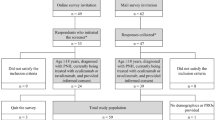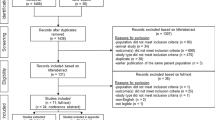Abstract
Thrombotic thrombocytopenia purpura (TTP) and atypical hemolytic uremic syndromes (aHUS) are distinct clinical disorders characterized by hemolytic anemia, thrombocytopenia, microthrombi, and end organ damage. TTP is characterized by a low ADAMTS13 activity level at diagnosis of <10 % ADAMTS13 activity, while aHUS is characterized as having >10 % ADAMTS13 activity. Despite clinical remission, survivors of thrombotic microangiopathy suffer significant comorbidity and decreased quality of life (QOL) than their healthy counterparts. The reason for this is unclear. Is it a lingering effect from their initial acute episode or ongoing subclinical injury/inflammation despite clinical remission? Common clinical complaints validated in practice include increased depression, deficits in memory, concentration, mood, and mental endurance. We suspect headaches may be an important clinical tool toward understanding patient morbidity and decreased QOL. To date, no studies report headache frequency or severity in this population. To answer this question, adult patients >3 months since their last acute episode of TTP or aHUS were approached to take a Headache Impact Test (HIT-6) survey. Between June 1, 2013 and May 30, 2014, 31 patients in remission (21 patients with prior TTP and 10 patients with prior aHUS) completed the HIT-6 survey. The survey scores were then compared to the HIT-6 normative population data established by Qualitymetric incorporated. Overall, TTP patients had a significantly higher average HIT-6 score of 59.9 compared to an average HIT-6 score of 51 seen in sex-matched controls (SD 9.6, p value 0.002). No significant difference was seen in the HIT-6 scores of aHUS patients. Of TTP patients studied, approximately 57 % (12/21) had three or more episodes and were >24 months since the last episode. The average time since last acute episode in TTP patients was 37.5 months. There was no significant correlation between TTP survivor HIT-6 scores and the number of prior episodes (1, 2, or >3) or timing from the last episode (3–6, 7–12, 13–24, or >24 months). About 19/21 (90 %) patients, who are TTP survivors, also had a normal ADAMTS13 activity level (>10 %) on the day of the survey. Our study suggests that headaches have significant impact on TTP survivors and should be followed in the clinical setting to prevent undue patient morbidity. Larger studies are needed to understand how headaches impact long-term survival and risk of relapse.
Similar content being viewed by others
References
George JN, Nester CM (2014) Syndromes of thrombotic microangiopathy. N Engl J Med 371:654–666
George JN (2006) Thrombotic thrombocytopenic purpura. N Engl J Med 354:1927–1935
George JN (2009) The thrombotic thrombocytopenic purpura and hemolytic uremic syndromes: evaluation, management, and long-term outcomes experience of the Oklahoma TTP-HUS Registry, 1989–2007. Kidney Int Suppl 75:S52–S54
Kennedy AS, Lewis QF, Scott JG et al (2009) Cognitive deficits after recovery from thrombotic thrombocytopenic purpura. Transfusion 49:1072–1101
Lewis QF, Lanneau MS, Mathias SD et al (2009) Long-term deficits in health-related quality of life after recovery from thrombotic thrombocytopenic purpura. Transfusion 49:118–124
Cataland SR, Scully MA, Paskavitz J et al (2011) Evidence of persistent neurological injury following thrombotic thrombocytopenia purpura. Am J Hematol 86(1):87–89
Deford CC, Reese JA, Schwartz LH et al (2013) Multiple major morbidities and increased mortality during long-term follow-up after recovery from thrombotic thrombocytopenic purpura. Blood 122:2023–2029
Yang M, Rendas-Baum R, Varon SF et al (2011) Validation of the Headache Impact Test (HIT-6) across episodic and chronic migraine. Cephalalgia 31(3):357–367
Nachit-Ouinekh F, Dartigues JF, Henry P et al (2005) Use of the headache impact test (HIT-6) in general practice: relationship with quality of life and severity. Eur J Neurol 12:189–193
Cataland SR, Holers VM, Geyer S et al (2014) Biomarkers of terminal complement activation confirm the diagnosis of aHUS and differentiate aHUS from TTP. Blood 123(24):3733–3738
Conflict of interest
The authors declare that they have no conflict of interest.
Author information
Authors and Affiliations
Corresponding author
Rights and permissions
About this article
Cite this article
Saultz, J.N., Wu, H.M. & Cataland, S. Headache prevalence following recovery from TTP and aHUS. Ann Hematol 94, 1473–1476 (2015). https://doi.org/10.1007/s00277-015-2411-2
Received:
Accepted:
Published:
Issue Date:
DOI: https://doi.org/10.1007/s00277-015-2411-2




